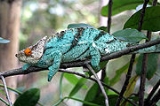
Parson's chameleon
Encyclopedia
The Parson's chameleon (Calumma parsonii) is a very large species of chameleon
that is endemic to isolated pockets of humid primary forest in eastern and northern Madagascar
. It is listed on CITES Appendix II, meaning that trade in this species is regulated. As with the majority of chameleon species from Madagascar, it is illegal to import Parson's chameleons from their native country.
), males have ridges running from above the eyes to the nose forming two warty horn
s. There are two recognized subspecies
: The widespread Calumma p. parsonii reaches up to 68 cm (27 in) in length (about the size of a cat) and has no dorsal crest. Calumma p. cristifer from near Andasibe
reaches 47 cm (18½ in) and has a small dorsal crest. Several colour variants are known within the range typically included in the nominate subspecies, but it is unclear if they are best considered morphs or different subspecies (at present, most consider them morphs). This includes "orange eye" aka "white-lipped" (generally consider typical of the nominate subspecies) where the male is relatively small and mainly green or turquoise
but with yellow or orange eyelids, "yellow lip" where the male is somewhat larger and mainly green or turquoise, but with a yellow edge to the mouth, "yellow giant" where the male is very large and overall yellowish (strongly marked with dusky when stressed), and "green giant" where the male is overall green. Males of C. p. cristifer are overall green or turquoise. Females of all are smaller than the males and overall greenish, yellowish or brownish (often with an orange tinge).
Chameleon
Chameleons are a distinctive and highly specialized clade of lizards. They are distinguished by their parrot-like zygodactylous feet, their separately mobile and stereoscopic eyes, their very long, highly modified, and rapidly extrudable tongues, their swaying gait, the possession by many of a...
that is endemic to isolated pockets of humid primary forest in eastern and northern Madagascar
Madagascar
The Republic of Madagascar is an island country located in the Indian Ocean off the southeastern coast of Africa...
. It is listed on CITES Appendix II, meaning that trade in this species is regulated. As with the majority of chameleon species from Madagascar, it is illegal to import Parson's chameleons from their native country.
Description
Among the largest chameleons in the world (variously reported as the largest, or second largest after the Malagasy Giant ChameleonMalagasy Giant Chameleon
The Oustalet's or Malagasy Giant Chameleon is a very large species of chameleon that is endemic to Madagascar, but also has been introduced near Nairobi in Kenya . It occurs in a wide range of habitats, even among degraded vegetation within villages, but is relatively rare in primary forest...
), males have ridges running from above the eyes to the nose forming two warty horn
Horn (anatomy)
A horn is a pointed projection of the skin on the head of various animals, consisting of a covering of horn surrounding a core of living bone. True horns are found mainly among the ruminant artiodactyls, in the families Antilocapridae and Bovidae...
s. There are two recognized subspecies
Subspecies
Subspecies in biological classification, is either a taxonomic rank subordinate to species, ora taxonomic unit in that rank . A subspecies cannot be recognized in isolation: a species will either be recognized as having no subspecies at all or two or more, never just one...
: The widespread Calumma p. parsonii reaches up to 68 cm (27 in) in length (about the size of a cat) and has no dorsal crest. Calumma p. cristifer from near Andasibe
Andasibe-Mantadia National Park
Andasibe-Mantadia National Park is a 155 square kilometre protected area consisting principally of primary growth forest in Alaotra-Mangoro Region in eastern Madagascar. The park's elevation ranges from 900-1250 meters, with a humid climate. Average annual precipitation is 1700 mm, with rainfall...
reaches 47 cm (18½ in) and has a small dorsal crest. Several colour variants are known within the range typically included in the nominate subspecies, but it is unclear if they are best considered morphs or different subspecies (at present, most consider them morphs). This includes "orange eye" aka "white-lipped" (generally consider typical of the nominate subspecies) where the male is relatively small and mainly green or turquoise
Turquoise (color)
Turquoise or is a slightly blueish tone of light green. The color is based on the gem turquoise. The term comes from the French for Turkish.At right is displayed the X11 color named turquoise....
but with yellow or orange eyelids, "yellow lip" where the male is somewhat larger and mainly green or turquoise, but with a yellow edge to the mouth, "yellow giant" where the male is very large and overall yellowish (strongly marked with dusky when stressed), and "green giant" where the male is overall green. Males of C. p. cristifer are overall green or turquoise. Females of all are smaller than the males and overall greenish, yellowish or brownish (often with an orange tinge).

